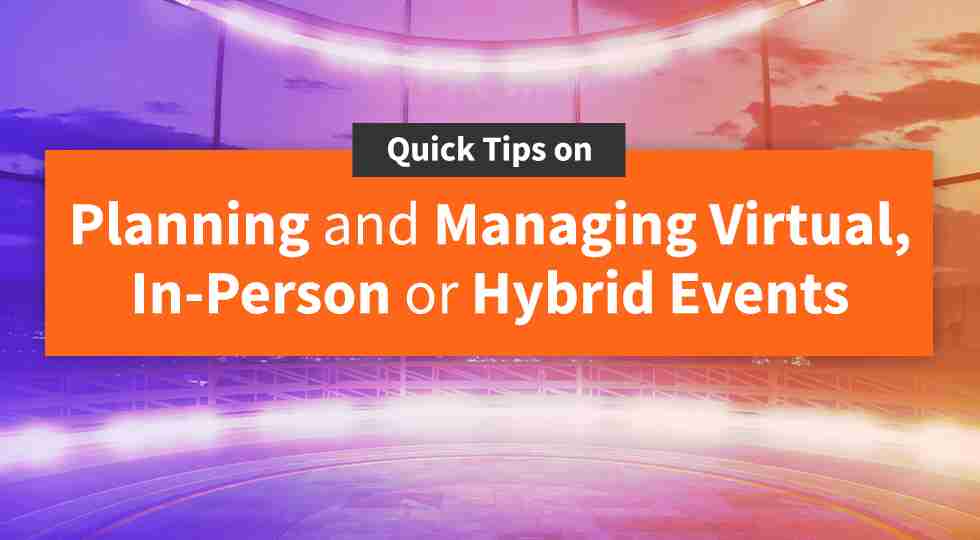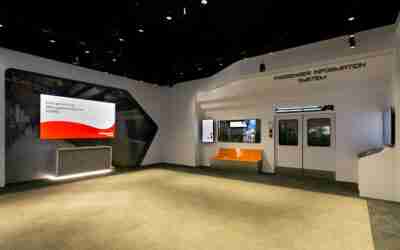
Event management and planning in Singapore has taken quite a turn in the past 2 years. With the onset of COVID-19, businesses had to pivot dramatically within a short period of time to accommodate needs that must adhere to social-distancing guidelines. Virtual events are now the default. Even as Singapore prepares itself for a “new normal” with COVID-19, we can expect virtual and hybrid events to take precedence over physical events. In the first place, virtual events do have their own advantages, with the reduction of traditional overhead costs (e.g. venue rental, F&B and setup) and tapping into new audiences with higher penetration online. Keeping that in mind, here are some quick tips to planning virtual or physical events.

Use AI software to manage logistics of the event
The majority of event management software are able to conduct registration management, conference or exhibit management and collect audience data for insights. Using AI to help automate processes helps to save time and streamline processes. Event planning can be extremely stressful with multiple moving parts all at once. Imagine having to track more invitations or registrations for more than 200 participants manually. Utilising the right software helps to cut down unnecessary administrative work that can be better deployed elsewhere. Different software offer variation in their services, where some are mobile integrated, while others sit solely on a web management platform software. The added advantage of mobile event applications being that they often provide a greater sense of convenience with in-app messaging and intuitive screen press polling functions.

Send out event merchandise way ahead of time
Event swag or merchandise was one of the highlights of physical events. Some trade fairs and exhibitions even have such memorable goodie bags that attendees make it a point to never leave without one. With virtual events, event swag is a great way to help create that sense of community and generate brand awareness. Event swag is also a cost-efficient form of advertising. With social media acting as an accelerant, attendees can easily snap a picture of their merchandise. Posting it on their social media with relevant hashtags can help drive momentum for it to “go viral”. With physical or in-person events, event swag can even be used as part of event deployment. For instance, Custom design wearable badges with RFID or QR coding can not only be used for registration purposes, but can be utilised for gamification. These are able to help keep track of participants across an entire, along with their virtual scoreboard, which adds a new interaction element. Wearable merchandise can thus help to create more buzz during an event, particularly when participants are able to use and emotionally connect with the merchandise.

Consider professional services
While shortlisting the services of an Event Management Company (EMC), it is important to consider professional services that are within their in-house capabilities. This applies to the varied demands of both virtual and physical events such as special effects lighting, augmented reality and high quality productions. While most event management companies are able to provide a basic bundle of services, it is important to look at how an EMC can help to differentiate your participants’ experience for your next event. An EMC with in-house creative and production capabilities can go a long way to helping you deliver an engaging and immersive event experience.

Timing is everything
It is important to identify ideal timings when deploying a virtual or hybrid event, especially with the advent of remote working and international participants forming the bulk of attendance. Ideally, the start and end time of an event should adhere to participants coming from key markets and their time zones. Having greater penetration with online connectivity means nothing if participants see the timing as disadvantageous to them. Knowing your audience and their prospective schedules is important as well. Does your event date clash with any major festivities, or will attention be diverted away due to other online occasions such as Black Friday? Annual events that are heavily advertised can be distracting and can reduce the available online space to reach out to your audience. It is important to consider how your event can fit into their working cycle, while minimizing eyeballs being drawn elsewhere. Lastly, the event date should be in sync with your brand. Capitalise on exciting announcements such as product launches or annual conferences to maximise momentum for your event.

Create buzz via social media
Social media marketing should be a serious consideration when it comes to getting the word out, as well as to increase sign-ups for virtual, physical or hybrid events. There are several things a social media strategy can incorporate for organic growth, by sharing regular updates and community building through online engagement. Substantial hype can also be created by utilising paid social media advertisements. This is a commonly used marketing tool which is very ROI dependent, and requires consistent tracking of user analytics conversion and engagement rates. As the saying goes, you cannot achieve what you cannot measure. Paid advertisements are a simplified way to allow businesses to target demographic groups that are relevant to their product offering. Needless to say, choosing the right social media platform is just as important. When advertising for a trade fair, Linkedin would be a much better platform than Instagram and Facebook, given that this is oriented towards business considerations. The audience profile is also more relevant. That said, you can post on Instagram as part of social media engagement. The content may have to be tweaked accordingly. Pictures of an exhibition or trade show can be posted on Instagram, but this becomes more focused on using pictures with accompanying hashtags, rather than long descriptions that the Instagram audience may not bother reading.

Take time to brief your speakers
For speakers, skills are not necessarily transferable between physical and virtual event settings. With in-person events, participants are able to see and interact with Speakers, and form an organic connection with them. On the virtual front, there is much more of a disconnect. Speakers are expected to be concise but engaging, or focus specifically on content without necessarily being able to draw on their personal experiences. The online audience does not have the same level of patience. For virtual events, it is important to remind speakers to stay on message. Content should be planned to be as interesting and it is concise as possible.
This ties in to the next point, where “webinar fatigue” is real. Capturing attention spans online can be an art. When attendees are having to face a screen for three or four hours in one sitting, it is no surprise when they lose focus. After all, this is completely different to in-person events, where a great part of the experience is being able to interact with other people. Connecting via a screen may be easier, but we must account for how easily participants can get sidetracked.
The whole session can quickly become unproductive when keynote speakers are perceived to drone on without intermittent breaks, or if the content no longer seems relevant. It is useful to incorporate audience engagement tools, including polls, live chats, or direct responses to questions during speaker segments to keep participants engaged.

Always perform a full-dress rehearsal to troubleshoot
There are three main teams behind virtual, in-person or hybrid events. These can be broken down into the tech, production and staffing team. During the first technical run-through, the tech team is in charge of ensuring that all equipment and technical specifications are in order for the event to run smoothly. This would mean connecting to sites and servers that replicate the exact conditions on the same day of the event, and ensure that all types of devices are able to connect seamlessly. The production team will complete a rehearsal for the full sequence of events, and iron out the nitty gritty. This could include the transitions between keynote addresses, video or animated content, and other presentations. Doing a full run through helps the teams take note of possible issues and blind spots ahead of the event.

Be picky When Choosing Platforms
There is a wide array of event management software to choose from these days. It can seem like a daunting decision to make especially when pivoting from physical to virtual events. Make a list of what you require from the event planning perspective, and feel free to reach out to experts on identifying a platform that can meet your requirements. For example, Zoom and Microsoft teams are often used for online conferences, as most demographic groups are familiar with them. Most companies have pre-existing licenses to tap on, and even if they don’t, premium accounts are fairly affordable. Conference management and breakout sessions can be hosted fairly easily, while most participants will have minimal issues with the user interface. Customisable or bespoke platforms, such as Hopin, Bizzabo and ON24 can offer other functions, but this really depends on the scope of your event. While all three platforms have been lauded for how they can manage both digital and onsite audiences, new users will need time to orientate and familiarise themselves. Prioritise the key tasks that account for a successful event and approach professional event planners for any consultations to optimise your intended event experience.

Let attendees mingle
According to a 2018 study by the International Association of Exhibitions and Events, 76% of 9,000 event participants listed networking as a huge driving factor for their attendance and 89% would attend more often if barriers were removed. Barriers such as having the resources to fly to an event venue and scheduling were some of the usual concerns when it comes to attending exhibitions or fairs in-person. A virtual event takes away most of these accessibility issues. The advantage of virtual events include being able to reach out to almost anyone with a connected device. This significantly increases the penetration rate for previously untapped markets or hard to reach demographic groups. However, virtual networking can lose its lustre for different reasons. Interactions can feel less organic when participants are placed into breakout rooms and their conversation disrupted by lack of interest or connectivity issues. To rectify that, lead conversations with engaging hot-button topics, and rotate participants often (such as in speed dating) to maximise engagement and networking.

Follow up after the event
A post-event mailer is usually a ‘thank you’ note that includes a brief recap of the highlights of the event and ways to stay in contact afterwards. Online users that interact with the mailer are more likely to become qualified leads. Prior to the end of the event, consider including a post-event survey to collect feedback. Breaking down the data will offer insights and possible areas of improvement for the next event. This information is valuable, as it gives you a snapshot of what matters to participants and where industry trends are possibly headed. Lastly, encourage attendees to visit your event social media pages and engage with the content. Incentivising them to do so through prizes and games definitely helps! This can be used to build a community of like-minded individuals that further strengthens your brand awareness online. This can be bolstered by special product launches, announcements and exclusive promotions, which can all be deployed as part of your content roster in line with your event. These methods can create a call to action, as there is a finite amount of time to respond. Generate buzz among participants that continuously keeps the brand’s presence fresh in their minds after the event.




